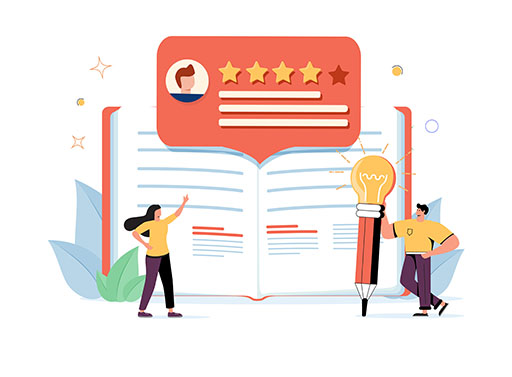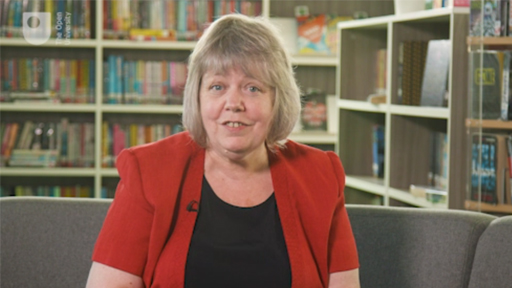1 Marketing your library’s offering to embed literacy
In the previous session, you considered the benefits of reading for pleasure. As fiction plays a particularly key role in fostering reading for pleasure and, consequently, literacy, you explored various ways in which fiction books can be promoted in your school. However, although fiction acts as a gateway to literacy, your library will also contain various other resources that have the potential to enrich students’ studies and further develop their literacy skills. It’s important, therefore, to focus attention in your marketing on the other benefits your library offers, for example, its digital resources, non-fiction collection, and other educational resources. By adopting a holistic approach to marketing that goes beyond just your latest fiction releases, you can maximise engagement with the different aspects of your library provision and encourage the development of literacy in your school. For this reason, this section will return to the topic of marketing, thinking in broader terms about the ways it can be used in your library to promote resources which help embed literacy in your school.

To promote your library and embed literacy, you don’t have to be an expert in marketing, nor must your initiatives and campaigns take up lots of time, materials and money. All that matters is that you keep your ideas fresh and ensure reading is actively encouraged, thereby helping to promote literacy. Making your library’s presence known throughout the school can entice students and encourage them to explore the wealth of opportunities it contains. Although some will need little encouragement to take full advantage of what your library has to offer, many students in your school may be reluctant to read or make full use of the library. Therefore, you must champion your library’s offering and engage stakeholders through creative marketing, for example, by creating reading lists, customised bookmarks, posters and displays, or even encouraging students to put brief book reviews on a feedback wall using sticky notes. You shouldn’t be shy about explicitly marketing the importance of literacy and the benefits of reading.
As you saw in the previous session, it's good to run week-long book campaigns throughout the year. These can be themed around genres or cultural events such as Black History Month, Women’s History Month, or major sporting events such as the Olympics. During these weeks, you can encourage students to engage with your offering by promoting relevant books, hosting events such as library readings and author visits, or even sharing podcasts and encouraging form tutors to get involved. Campaigns such as these are a particularly useful way to encourage students to explore non-fiction resources. As you will see later in this session, non-fiction books are equally key to literacy as they expose students to new concepts and ways of interpreting the world around them.
Reminding students of the wealth of digital resources available to assist their studies by placing posters near computers or in classrooms is a particularly helpful way of encouraging them to take advantage of your resources. It also shows that the library is not just a place for issuing and returning books, but an environment conducive to learning and the development of literacy.
You can also draw attention to new books and resources to promote literacy. By marketing your new resources, you can demonstrate that your library is dynamic, keeping up to date with current trends and responding to students’ interests. In this respect, it can be helpful to advertise new books which were requested by students, or put stickers on their cover saying who requested them. This can really emphasise to students that the library is a place which strives to meet their needs and support their interests.
However, it is not only new resources and collections you should actively promote. Where some books or resources have fallen through the cracks, innovative marketing and novel techniques can be used to generate interest and give them a new lease of life. This could involve a ‘Book in a Jar’ – a glass jar that contains objects related to a book’s storyline or title. You can encourage students to create them by offering prizes such as book vouchers to those whose clues lead to the most correct guesses. Other initiatives could include creating a vending machine for books or simply concealing their covers and encouraging children to choose one at random. Initiatives like these invite students to connect with books that they might not have otherwise explored and is an subtle way of promoting literacy. Once you put your mind to it, the possibilities are endless. In the video below, Sarah discusses her own approach to marketing and offers tips on how you can develop your own.

Transcript: Video 1
As Sarah mentioned in the video, incentives and rewards can be a helpful way to motivate students. However, is it important to be mindful that such schemes may de-motivate less established readers if they think they have no chance of completing the task or if a leaderboard is displayed. Equally some students may just read to gain points rather than to form a reading habit. It is therefore important to always combine any promotional schemes with verbal and written praise and encouragement.
Having listened to Sarah’s suggestions on how to market your library complete Activity 1. This activity will get you to consider how you currently market your library’s offering and think about the steps you have already taken to develop a reading-rich culture.
Activity 1
How much time do you devote to marketing your library and its resources?
Now, provide an example of how you have marketed your library’s offering to each of the following target audiences.
| Students | |
|---|---|
| Colleagues | |
| Parents |
Comment
Now that you have completed this activity, consider whether you have favoured one target audience more than another? If so, is there a benefit to this? Could you perhaps be doing more to market your offering to a wider range of audiences?
Having a marketing strategy which targets students, parents and colleagues is desirable and although students are naturally your key audience, it might be advantageous to also involve parents and colleagues as they can endorse your message.
Now have a go at Activity 2.
Activity 2
How do you help to embed the reading aspect of literacy throughout your school?
Discussion
Your answer to this question will be personal to you. There are no right or wrong answers to this activity, but below are some examples of the ways you may have contributed to literacy across your school:
- liaising with the literacy co-ordinator
- liaising with the heads of departments
- liaising with the head of Special Educational Needs and Disabilities (SEND)
- liaising with the admissions officer to ensure you cater for any students in the incoming cohort for whom English is a second language.
Organising author visits can be a really effective way of engaging your students and helping them to develop a love of reading. For example, by recounting their career, an author may be able to inspire and raise the aspirations of the students in the audience. This power of role models to influence behaviour and inspire students is a theme you will explore further in the next section where you will consider how to take advantage of the popularity of certain teachers and celebrities to help promote and champion reading.
